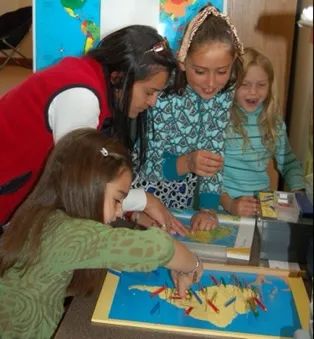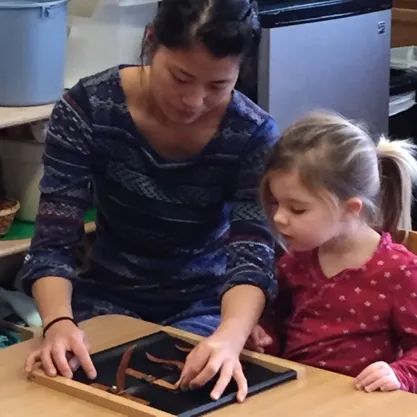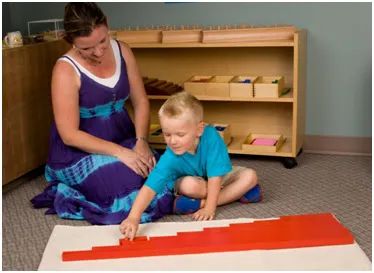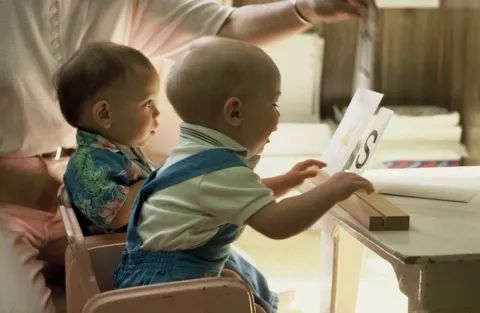Thinking About Becoming a Montessori Teacher: What to Consider
What Ages Do You Want to Teach?
If you are new to Montessori education, often the first question you might ask is “What makes Montessori different?” There are several big differences that vary in importance because of the needs of the different ages with whom you choose to work.
)-(1).jpg?fit=outside&w=1000&h=1500)
The prepared environment
Montessori classrooms are lovingly prepared based on decades of observation of the needs and interests of children in three-year age ranges: 0-3, 3-6, 6-9, and 9-12. Teachers are trained to make careful observations of individual children and introduce them to the materials and activities that suit their development. Virtually everything we want to teach children is done through some activity. We show them how to work with the material, and they proceed to teach themselves through repetitions.

The question of choice
Montessori children are given lessons on how to use the materials that are suited to their level. Then they are free to come in each day, select the materials that interest them, and work for as long as the activity holds their interest. It might be for a few minutes or it might be the better part of an hour. And it might be day after day for an extended period when the material we introduce matches what we call the “sensitive periods in development,” when the child is ripe for a particular skill to be learned.
- With infants and toddlers, there are relatively few choices in the environment and the activities do not seem very complex. Yet babies are working in subtle stages to develop such things as the muscles of the hand. There are more than a dozen stages the baby’s hand passes through to be able to grasp an object and bring it to the mouth. The process of learning to ask for what they need, to select one item from another, to proceed from babbling to the first word—all of these are stages in the early years, which we learn to provide for in the environment and to observe rather than control in any way.
- In the 3-6 early childhood environments, children are learning to function in a social setting and adjust to being out of the home and with peers for several hours per day. During these ages, there are several hundred choices, and it is largely the child’s choice of what to do on any given day. As the child nears the transition into elementary school, there are more limits on choosing language and math work each day, for example. The curriculum is largely based on four areas:
- Practical life, which includes care of the self, care of the environment, grace and courtesy, and gross motor activities
- Sensorial, which involves working with materials that refine and develop all of the physical senses, including sight with size, shape, and color, hearing, touch, smell, and taste. The sensorial materials also introduce the sciences and cultural subjects such as biology, geography, geometry, history, art, and music.
- Language, which goes from the development of oral language and vocabulary to developing phonemic awareness, letter knowledge, and word building as well as reading and writing.
- Math, which goes from basic counting and associating quantity with symbols, the decimal system of 1-10-100-1000, functions of the four operations of addition, multiplication, subtraction, and division on into the memorization of facts
- In the 6-9 and 9-12 age groups, children are still given choices, but they also have weekly assignments that must be completed followed by time to do any lessons they wish. Their curriculum expands to include math, geometry, language, history, geography, and biology, including botany and zoology. There is a new emphasis on research and children may hear a lesson introducing a new subject, such as Rome. They can select what area of Roman life they wish to study and then make an oral report to the class. In this way, each student has buy-in to what he wants to research, and as they share all they have discovered, they learn as much as they would have through reading a textbook. But this is much more interesting, and they learn to respect and show interest in one another’s work.

The question of time
In the Montessori classroom, children work on lessons with as many repetitions as needed until they are internally satisfied, and interruptions are avoided whenever possible.

The teachers’ role
Montessori teachers act as guides to students primarily on a one-on-one basis. They assist each child along the learning path, recognizing the uniqueness of each. This is true at any age level we teach.

Self-esteem
Montessorians understand that the child’s self-esteem comes from an internal sense of pride in her accomplishments. We always seek to assist the child to succeed by giving sequential parts of a whole operation so that she can proceed through each step with ease until it all functions together.

Love of learning
Montessori environments are intended to appeal to the child’s innate hunger for knowledge and they have proven successful for well over 100 years. Children learn to love learning and do so without testing and judgments on their work. Montessorians learn to assess by observing and adjusting lessons to what each one individually needs.

So, what about you?
Montessori teachers, on the whole, are dedicated to children and to making the world a better place.

Infants and Toddler: 0-3
Teachers for this age level need to be able to slow down and enjoy rocking babies, changing diapers during special one-on-one time, and taking quiet times on long walks with little ones in strollers. Teachers of the very young need to be able to spend hours observing children, learning to speak slowly and clearly with them, assisting them when they need it, and stepping back when they are happily occupied while keeping an eye out for their safety. There are periods when several babies are crying non-stop all at once and other times when there is little dynamic action. Teachers for this age level need to be okay with both scenarios.
In your training, you will learn a great deal about child development and the vital importance of movement, language, communication, and independence.

Early Childhood: 3-6
Teachers for this age range will find themselves helping children learn to use the bathroom, how to settle for naps, how to use words to solve problems, how to raise their hands in a group when it is their turn to speak, and how to line up to go outside.
On the lesson side of things, there are many pieces of what Montessori called “didactic material” that teachers learn how to present with precision. At this stage, teachers need to enjoy the challenge of precision. With these materials, they will help children pour water, polish their shoes, tie a bow, and grade colors, bells and textures. They will help them learn the sounds of the language and the letters that represent the sounds, how to hold a pencil, how to build words and eventually to write and read them. With the materials, early childhood teachers will help children learn to count and work with mathematical operations using concrete materials.
There needs to be a fascination with child development and the ability to step back and watch, curb the tendency to correct children who do not yet know how to do things, and infinite patience with what Montessori called, “the child who is not yet there.” Children will come to the teacher at this stage with no idea of the kinds of classroom standards in place, so you will need to find simple, non-challenging ways to teach by teaching and not by correcting.

Elementary: 6-12
Elementary teachers need to love the child but, in addition, it is a requisite to love the universe! Children at this age are entering what Montessori called the program of the Cosmic Plan. They love to learn about the whole universe and its parts! You as a teacher need to love to learn yourself, and love to impart learning. There are many topics to be shared with the children and it is important to realize that if you don’t know much about biology or geography, you can learn with the children. I call it becoming a “journeyman learner.” If you stay just a little bit ahead of where the children are or learn right alongside them, you will be fine.
If you enjoy conversations, children of this age will love to engage with you and the entire community. It is a time of “going out” in Montessori terms. Children learning about rivers need to go to a river. If they are learning about various foods, they need to go to a farm, then a production facility, and then trace the process to the store and their table.
Another quality of the elementary teacher is to be able to laugh and have fun. Children love to laugh and when they learn that the teacher loves to laugh, too, there is an instant rapport and easy way of being natural in the classroom.

Satisfaction
Experience the joy of presenting a lesson and then watching the child do it all by herself.
Becoming a Montessori teacher or guide is a career step that brings a satisfaction few other jobs offer. You are working with individual children and helping them to become the best they can be. If you are thinking about it and deciding what age to teach, go and observe in as many schools as possible. Spend some time in the age-range classroom environment in which you think you’d like to work. Talk to the teachers, parents, and administrators. You may want to see if you can volunteer in the classroom for some time, so you can see what it is like. If visits are not possible, get on the Internet and watch videos of Montessori classrooms.
Whatever age you would like to work with and support, you can become a professional Montessorian with Age of Montessori. We are here for you and the world’s children!























